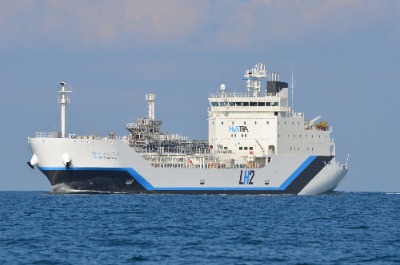February 2022 H2 cargo onboard Suiso Frontier from Australia hailed a success despite concerns over Japan shifting its emissions overseas
A consortium of Japanese companies has been celebrating what they call the world’s first voyage of liquid (brown) hydrogen cargo onboard a dedicated vessel.
Suiso Frontier carried the cargo from Australia to Japan in February this year (2022). The hydrogen for this cargo was however made from brown coal gasification, a process which is not considered green due to the CO2 emissions emitted during the production of the hydrogen.
The Japanese consortium are however saying that this is a demonstration of green hydrogen supply chain potential now that the development of a full liquid hydrogen supply chain has been made possible.
The shipment was part of the HySTRA project where the acronym is an abbreviation of the Japan CO2 Free Hydrogen Energy Supply chan Technology Research Association. Partners in the association/joint venture are Iwatani Corporation (who operate the demonstration cargo handling terminal in Kobe), Kawasaki Heavy Industries (design and build f the ship and cargo handling terminal) , Shell Japan who are operating and crewing the vessel, J-Power (who are making the hydrogen from coal in Australia, Marubeni, ENEOS, K-Line.
The shipment has demonstrated the feasibility of making a significant volume of hydrogen, cooling it into a liquid, then loading it onto a vessel for a long haul voyage. While LNG shipments are common place, there are some significant additional challenges with hydrogen, which is one of the lightest molecules and can easily pass through many materials.
Hydrogen can be stored either as a liquid or as a compressed gas. As a liquid it needs cryogenic temperatures as the boiling point of hydrogen at one bar is -258 degrees. It can also be stored on or within solids (absorption).
The whole project has been heavily subsidized by the Japanese and Australian governments. Australia is keen to find new ways to better utilise its coal reserves as the fossil fuel becomes less popular, and likewise Japan is seeking other channels of energy security given the dominance of coal and natural gas in the country.
There are also efforts in Australia to deploy carbon capture in the country to enable the production of blue hydrogen from coal, although environmental lobby groups in Australia say this is not environmentally feasible. A recent research paper on ammonia use in Japan pointed to the risks that Japan will be simply shifting its CO2 emissions to Australia if this hydrogen supply chain grows as planned.

































